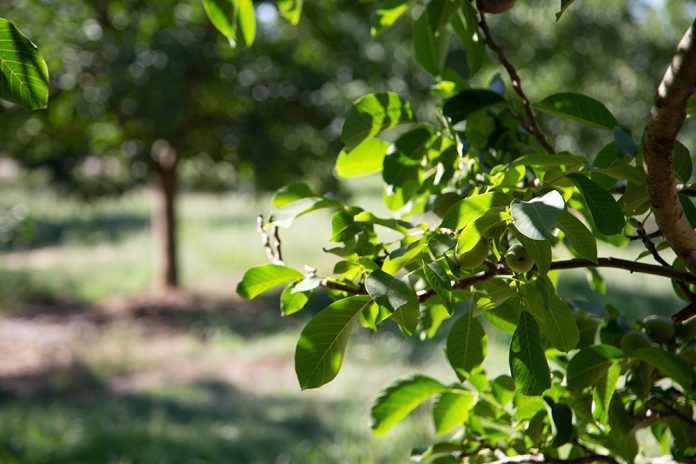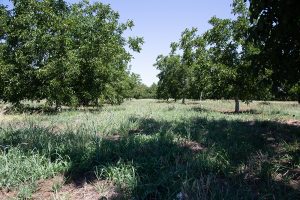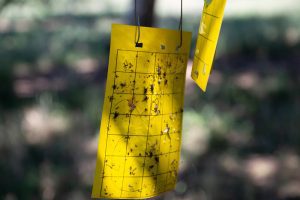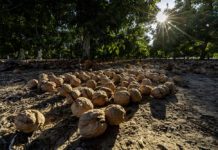
A project focusing on integrated pest management (IPM) in walnut orchards that uses the entire orchard system is in its second year of demonstrations and trials in Sacramento and San Joaquin Valleys.
The project, funded by CDFA, incorporates a Biologically Integrated Orchard Systems (BIOS) approach and focuses on walnut production systems targeting codling moth, navel orangeworm (NOW) and webspinning spider mites, three key pests in California walnut orchards.
As was noted in an article for the May/June 2021 edition of Progressive Crop Consultant magazine that introduced the project, Community Alliance with Family Farmers (CAFF) has worked closely with UCCE and participating growers and PCAs on six walnut farms (three in the Sacramento Valley, three in the San Joaquin Valley) since 2021 to set up the project’s BIOS demonstration sites. At these sites, alternative pest management practices, including mating disruption for codling moth and NOW and biological practices for spider mites, are being implemented along with robust monitoring programs, UC IPM models and action-based thresholds.
In mid-July, CAFF held a demonstration for the BIOS for Walnut project at one of its six sites at Blossom Farms in Stockton, Calif. Here, local PCA Mike Devencenzi, UCCE IPM Advisor Jhalendra Rijal and CAFF researcher and Project Lead Hanna Kahl spoke about what they’re seeing regarding the whole-system approach to IPM.
Mating Disruption Aspect
CAFF and project participants anticipated at the start of the project that mating disruption will effectively manage codling moth and NOW at its six demonstration sites with little to no use of broad-spectrum pesticides. Mating disruption for codling moth has been proven in previous UCCE research but is still being demonstrated for NOW.
At the Stockton site, Devencenzi said mating disruption dispensers are dispersed one per acre throughout the orchard. Rijal said that low codling moth rates are undeserving of treatment, especially given current walnut prices. Kahl said the orchard might have been getting benefits from neighboring orchards with codling moth mating disruption before the trial began.
Standard monitoring methods are being used at the site. Devencenzi recommends to not use traditional pheromone lures with mating disruption as the numbers might create a false sense of security for growers. Instead, he recommends kairomone lure or kairomone lures with pheromone.
Rijal said pheromone and PPO lures for NOW should not be near each other to reduce interference. 200-foot spacing is recommended. PPO lures are not permitted in organic orchards.
Comparing infestations in walnut and almond orchards, second flights for codling moth in July are always lower in walnut than in almond. That number will go up for walnuts in third and fourth flights and is recommended to be kept in mind when monitoring. When hull split and codling moth flights are synchronized, higher damage can be expected.
While there are no mating disruption dispensers for NOW at the Stockton site, dispensers have been implemented at other BIOS sites in the Northern San Joaquin Valley. Data taken from all five sites with NOW mating disruption show reduced mean numbers of NOW moths per day between April and July compared to no mating disruption, and at two sites, mating disruption reduced the proportion of harvested nuts infested by NOW.
Kahl said that even with only codling moth mating disruption used at the Stockton site without the presence of mating disruption specifically for NOW, a reduction in harvested nuts infested by NOW was seen. This could be because codling moth can provide earlier entry to the nuts by NOW.
Biological Control of Mites
In addition to mating disruption for codling moth and NOW, the BIOS project also has three research and demonstration sites that focus on managing webspinning spider mites using the release of predatory mites and increasing habitat for beneficial insects through the planting of cover crops.
At this Stockton site, increased minute pirate bugs, which also feed on spider mites as well as aphids and psyllids, were found on sticky cards in the cover crop treatment, particularly in the early season before the cover crop was mowed.
It is important to note that a specific cover crop mix was planted in the trial to attract different predatory arthropod species.
When monitoring for spider mites in the orchard, the biggest thing, according to Devencenzi, is water. He recommends scouting with a soil auger to check soil wetness as drier soils are more conducive to spider mite activity. Also, predatory mites prefer humid conditions to establish, so an irrigation before and after release is recommended, Kahl said.

Other Whole-System Strategies
There are a number of other alternative IPM strategies being investigated outside the BIOS for Walnut project. Devencenzi, Kahl and Rijal mentioned a few during the field day in Stockton.
There is evidence that cover crops can help with controlling Phytopthora, Devencenzi said. Phytopthora attacks plant roots; it is possible that because cover crops can improve soil penetration, they can mitigate negative effects of the disease. Note that like the attraction of certain predatory insect species to cover crops, the ability to mitigate Phytopthora likely would depend on the specific cover crop mix.
Kahl pointed to research looking at the possibility of mummy nuts being decomposed faster on the ground with cover crop, possibly allowing some reduction in overwintering NOW. Growers have attested to and observed this, she said. However, walnut decomposition is slower compared to almond or pistachio due to the nut’s thicker shell, so shredding mummies will always be faster for eliminating infested nuts regardless.
Research into walnut husk fly biologicals is being worked on as well. Since husk fly pupate on the ground for half the year, a control strategy for the ground involving applications of pathogenic fungi is being investigated. The idea is that the fungi will release toxins in husk fly larvae in the soil, killing the larvae. Results are promising thus far, according to Rijal.

What’s Next?
The BIOS for Walnut project will continue at each of the six California sites through 2023, focusing on disseminating knowledge through field days. Thus far, multiple field days have been held and will continue to be held in the Sacramento and Northern San Joaquin Valleys to share findings and hear from participating and experienced growers.
The project is continuing to develop a wide range of extension resources, project updates and results (biological, pest and economic analyses); technical information highlighting up-to-date research and IPM recommendations; pest management decision-making tools and perceived risks and strategies for mating disruption and biological control; and grower perspectives of benefits and tradeoffs of the BIOS approach.















